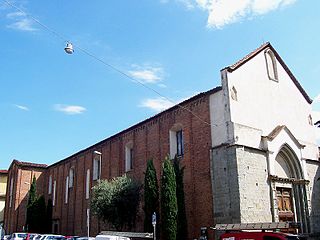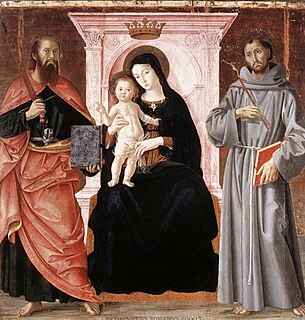
Paolo Uccello, born Paolo di Dono, was a Florentine painter and mathematician who was notable for his pioneering work on visual perspective in art. In his book Lives of the Most Excellent Painters, Sculptors, and Architects, Giorgio Vasari wrote that Uccello was obsessed by his interest in perspective and would stay up all night in his study trying to grasp the exact vanishing point. While his contemporaries used perspective to narrate different or succeeding stories, Uccello used perspective to create a feeling of depth in his paintings. His best known works are the three paintings representing the battle of San Romano, which were wrongly entitled the Battle of Sant'Egidio of 1416 for a long period of time.

Saluzzo is a town and former principality in the province of Cuneo, in the Piedmont region, Italy.

Crema is a city and comune in the province of Cremona, in the region of Lombardy in northern Italy. It is built along the river Serio at 43 km (27 mi) from Cremona. It is also the seat of the Catholic Bishop of Crema, who gave the title of city to Crema.

The Church of St. Mary of the Admiral, also called Martorana, is the seat of the Parish of San Nicolò dei Greci, overlooking the Piazza Bellini, next to the norman church of San Cataldo, and facing the Baroque church of Santa Caterina in Palermo, Sicily, southern Italy.

Brugherio is a comune (municipality) in the Province of Monza and Brianza in the Italian region Lombardy, located about 10 kilometres northeast of Milan. It was established December 9, 1866 unifying the suppressed municipalities of Baraggia, San Damiano and Moncucco, together with the villages of Bindellera, Cesena, Gelosa, San Paolo, Torazza, Occhiate and Increa.
Ostiano is a comune (municipality) in the Province of Cremona in the Italian region Lombardy, located about 90 kilometres (56 mi) southeast of Milan and about 20 kilometres (12 mi) northeast of Cremona. As of 31 December 2004, it had a population of 3,054 and an area of 19.4 square kilometres (7.5 sq mi).

Altobello Melone was an Italian painter of the Renaissance.

Simone Peterzano was an Italian painter from Bergamo, but stressed his links to Venice where he probably trained. He painted in mannerist style and is mostly known as the master of Caravaggio.

San Maurizio al Monastero Maggiore is a church in Milan, Northern Italy. It was originally attached to the most important female convent of the Benedictines in the city, Monastero Maggiore, which is now in use as the Civic Archaeological Museum. The church today is used every Sunday from October to June to celebrate in the Byzantine Rite, in Greek according to the Italo-Albanian tradition. It is also used as concert hall.

Our Lady of Graces or Saint Mary of Graces is a devotion to the Virgin Mary in the Roman Catholic Church. Several churches with this dedication often owe their foundation to thankfulness for graces received from the Virgin Mary, and are particularly numerous in Italy, India, Australia, United States, Portugal, France and the Italian-speaking region of Switzerland. Also it is related to the Marian apparitions in which was revealed the Miraculous Medal, also known as the Medal of Our Lady of Graces.

San Bernardino is a church in Verona, northern Italy. The church, in Gothic style, was built from 1451 to 1466.
San Marino is a small landlocked country with an area of about 61.2 km2 (23.6 sq mi) on a rocky promontory at an elevation of 657 meters (2,156 ft) in central Italy. It is the third smallest country in Europe after Vatican and Monaco. It was founded as a Republic in 600 AD and recognized by the Papacy in 1631, and became a member of the United Nations in 1992. As of 2009, it had a population of 31,500. The ethnic composition is about 84.95% Sammarinese, 14.6% Italians and others. The country does not provide exact statistics of the religious affiliations of its people. However, it is inferred that at least 95% of the people are Catholics, as in Italy, but with a historical Jewish and Protestant minority. There are other small groups, including Jehovah's Witnesses, Waldensians. San Marino's schools are all public and financial support is provided by the State; there are no private religious schools.

Zanobi di Benedetto di Caroccio degli Strozzi, normally referred to more simply as Zanobi Strozzi, was an Italian Renaissance painter and manuscript illuminator active in Florence and nearby Fiesole. He was closely associated with Fra Angelico, probably as his pupil, as told by Vasari. He is the same painter as the Master of the Buckingham Palace Madonna. Most of his surviving works are manuscript illuminations but a number of panel paintings have also been attributed to him, including seven altarpieces and six panels with the Virgin and Child, along with some designs for metalwork.

San Domenico is a Romanesque and Gothic-style, Roman Catholic church located in the Piazza of the same name, with a north flank of the nave parallel to Corso Silvani Fedi, in Pistoia, region of Tuscany, Italy.
San Giuseppe Sposo is a medieval Roman Catholic church and convent, now respectively parish church and museum, near Porta Saragozza in Bologna, Italy.

San Paolo is a former convent in central Parma, Emilia-Romagna, northern Italy. It is best known for housing the Camera di San Paolo, decorated by a masterpiece of fresco work (1519) by Correggio.

The Church of Our Lady of the Graces is a Gothic-style, Roman Catholic church in Varallo Sesia, province of Vercelli, region of Piedmont, Italy. The church was built, together with the adjacent Franciscan convent, by padre Bernardo Caimi between 1486 and 1493. At this time, the construction of the Sacro Monte was also beginning. In December 1931, Pope Pius XI gave the church the title of Minor Basilica.

The Enthroned Madonna and Child with Saints Paul and Francis is a painting by the Italian Renaissance painter Antoniazzo Romano. It was originally the main altarpiece of the church of San Paolo, part of a Franciscan monastery. In the 20th century, it was requisitioned and restored at the request of the art historian Adolfo Venturi, and now is housed in the Galleria Nazionale d'Arte Antica of Palazzo Barberini, Rome.

The church of San Francesco of Assisi is a Catholic religious building in Pavia, Lombardy, Italy.
















